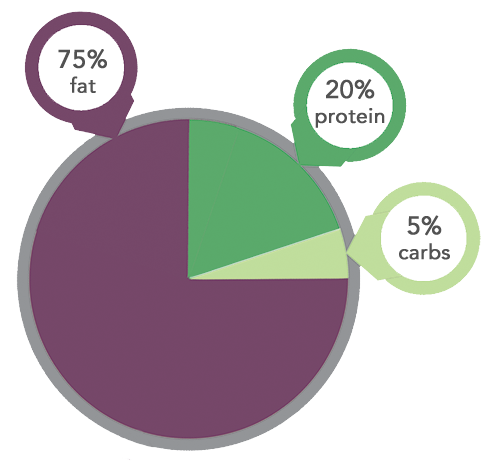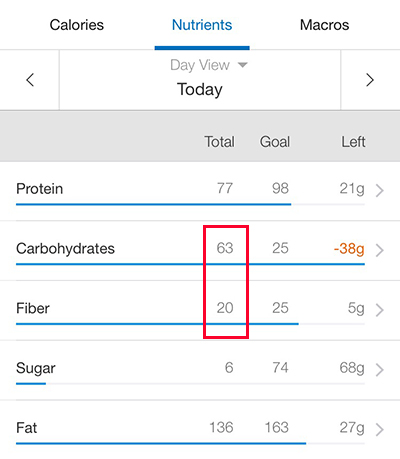What are macronutrients?
Spend any amount of time in online keto communities and you will see people talking about their macros: adjusting their macros, fitting things into their macros, tracking their macros … what does it all mean?
“Macros” is short for macronutrients, which are “nutrients required by the body in the greatest quantities.” The three types of macronutrients are fat, protein, and carbohydrates.
The recommended macronutrient breakdown for the standard American diet, as a percentage of total calories, is:
- 45-65% carbohydrates
- 10-35% protein
- 20-35% fat
Clearly, this is too high in carbohydrates for our purposes. According to Jeff Volek and Stephen Phinney, authors of The Art and Science of Low Carbohydrate Living, there is no such thing as carbohydrate deficiency. Although some parts of the brain require carbohydrates, the body can make whatever carbs it needs through a process known as gluconeogenesis, in which protein is converted to carbohydrate.
There are, however, significant health problems associated with deficiencies in protein and fat. Fat and protein are required for many processes throughout the body, including cell growth, division, and repair, as well as the proper function of many internal organs. So for a low-carb, ketogenic diet, we want to significantly reduce our carbohydrate intake, while increasing our fat intake and keeping protein intake moderate.
The standard macronutrient breakdown for a ketogenic diet is:
- 5% carbohydrates
- 75% fat
- 20% protein
Important note: These figures refer to a percentage of your caloric intake, not grams. The typical number of grams of carbohydrates in a ketogenic diet is approximately 20 net grams during adaptation, and approximately 50 net grams once you’re keto adapted.
The number of grams you eat for fat and protein will vary depending on your ideal calorie intake and your goals (e.g. weight loss or maintenance).
Don't fear the fat!
It can be difficult for many people to wrap their heads around the idea of including so much fat in the diet, when the leading health organizations have been telling us for decades that fat is evil and the source of weight gain and degenerative, age-related diseases like cardiovascular disease. But actually, the culprit here is sugar (i.e. carbohydrates). Sugar leads to weight gain, depresses the immune system, ages the skin, feeds cancer cells, and contributes to internal inflammation, which is the underlying cause of all major disease.
Some people think they can do a low-carb, low-fat diet. This is a mistake. If you’re both low carb and low fat, that leaves you with one thing: high protein. And a high-protein diet is associated with accelerated aging and a shorter lifespan. On a keto diet, your protein intake should be a moderate 20 percent.
There are numerous benefits to training your body to use fat as its primary source of fuel. According to Volek and Phinney, the heart and brain are 25% more efficient when powered by fat. Low-carb diets can lead to weight loss, increased energy, better sleep, and clearer skin. So go ahead: eat the skin on your chicken. Get the 80/20 ground beef (or 70/30 if you can find it). Eat the eggs and bacon. It may take some time to break yourself of the habit of reaching for low-fat or "lean" foods, but the benefits are worth it.
Putting it all together
Many foods contain at least two macronutrients, so keep this in mind as you are planning meals. For example, grass-fed beef and salmon are good sources of both fat and protein. Every meal should contain a source of fat and protein. If your protein is lower in fat, such as poultry, try adding add more fat in your meal, such as olive oil, avocado, or coconut oil.
I also make a point to include plant foods in every meal. Because we’re only concerned with net carbs (total carbs minus fiber), non-starchy plant foods increase your carb count by very little.
Should you track your macros?
Many people choose to use an app like MyFitnessPal or something similar to track their macros. (There are several keto-specific apps you can use; most have limited functionality unless you buy a monthly subscription.) This can be extremely helpful when you’re just starting out, so you can make sure your fat is high enough and your carbs are low enough to keep you in ketosis.
If using MyFitnessPal, you can set your desired macronutrient percentages, but be aware that it only tracks total carbs, so you will have to subtract your fiber to get your net carbs. You can set your food diary to display fiber under Food / Settings / Nutrients tracked. (This option is available in the free version.)
Even though I'm well above 5% carbs here, I'm only at 43 net grams, which is below my goal of 50 grams. Percentages are a guideline, not an absolute.
I tracked my macros for the first month to make sure I was on the right track, and then I stopped. Why? For one thing, I found it to be a hassle to enter everything I ate. Also, I tend to eat a lot of the same foods, so I know what works in my diet. For many people, tracking macros can also feel overwhelming and just leads to more anxiety around their diet, which is something we’re trying to avoid. Food should be your friend and a source of fuel — not a source of anxiety.
Another approach is to simply write down the number of carbs you eat, and don’t worry about tracking fats or protein, as long as you know you’re eating enough fat. Do what works for you.
You can also use urine strips in the beginning to make sure you’re in ketosis, but these tend to be less effective over time, as your body become more efficient at recycling ketones, so you excrete less of them.
Eventually, you’ll know what it feels like to be fat adapted, and you may not feel the need to track what you eat.
Getting started on keto
If this all sounds confusing, don’t worry! You will get the hang of it, and you will soon learn what 75% fat and 5% carbs looks like on your plate.
My advice for getting started:
- Download the keto start guide and read through it so you know what to expect.
- Follow the meal plan in the start guide, or choose a few meals you like that fit the macronutrient breakdown.
- Keep it simple! There are a lot of delicious, fancy keto recipes out there, but don’t start with them. You’ll get overwhelmed, plus it can be expensive to make “keto-fied” versions of favorite foods like bread or bagels. There’s plenty of room for experimentation later.
- Get yourself into ketosis, and then you can worry about adjusting your macros and trying different foods. If you try to make sense of it all first, you’ll never figure it out! Just get started, and you’ll learn more as you go.
Ready to get started on keto?
Download my free keto start guide to learn what to buy, what to expect during your first month, and what to eat as you start your ketogenic diet!
Subscribe to my mailing list





Follow Me